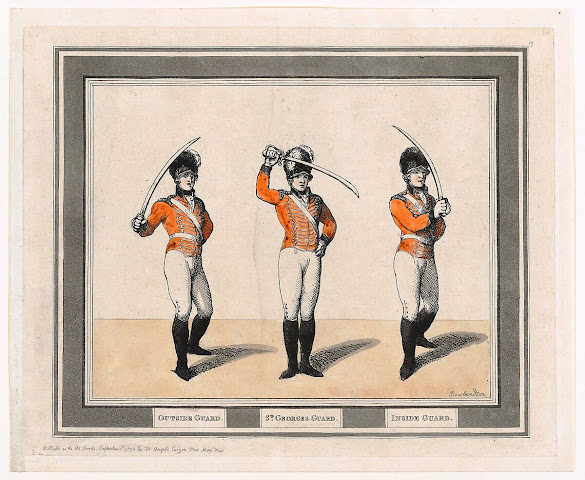Author’s note -- I hope that you enjoy learning from this resource! To help me to continue to provide valuable free content, please consider showing your appreciation by leaving a donation HERE. Thank you and Happy Trails!
The roots of the Anglo-American military style of fencing
grew out of two separate traditions: the broadsword traditions of the Scottish
Highlands and the English style of post renaissance fencing.
The English backsword method was built around the Medium,
Inside, Outside, St. George’s and Hanging guards, as set out in English
civilian manuals.
The Scottish traditions of sword-play, which were influential
in the development of all later Anglo-American sword-play styles, were brought
to the literary world with the publication of Anti-Pugilism or the science
of defence exemplified in short and easy lessons for the practice of the
Broadsword and Single Stick, (1790) by a ‘Highland Officer’, who has
been identified as Captain G. Sinclair of the 42nd Blackwatch.
The Scottish broadsword systems departed from the English
backsword method in three areas. The
three areas thought to be part of the Scottish Highlander’s broadsword
tradition, are as follows:
This is contrasted with the way the earlier English sword
masters had taught the Medium guard, or as they called it the ‘Unicorne
guard’. They taught that the Medium
guard was to be held with the arm fully extended and with the point threatening
your opponent. In this manner the guard
was used to keep your opponent at bay.
English sword masters taught that the Hanging Guard should be held in an extended fashion, on the Outside line (the right side of a right handed fencer). This manner of holding the Hanging Guard was later described as a ‘hanging guard in seconde’. This was the guard that George Silver describes as the ‘Imperfect Guardant’.
If you enjoyed this introduction to sword fighting, look for the next
chapter of The Practical Swordsman’s Pocket Compendium coming soon.
I hope that you enjoy
learning from this resource! To help me
to continue to provide valuable free content, please consider showing your
appreciation by leaving a donation HERE.
Thank you and Happy Trails!
I
hope that you continue to enjoy The Woodsman’s Journal Online and look for me
on YouTube at BandanaMan Productions for other related videos, HERE. Don’t forget to follow me on both The
Woodsman’s Journal Online, HERE,
and subscribe to BandanaMan Productions on YouTube. If you have questions, as always, feel free
to leave a comment on either site. I
announce new articles on Facebook at Eric Reynolds, on Instagram at
bandanamanaproductions, and on VK at Eric Reynolds, so watch for me.
That
is all for now, and as always, until next time, Happy Trails!
Sources
Amberger, J. Christoph; Officers and Gentlemen: On the
history of fencing at the U.S. Naval Academy, http://www.swordhistory.com/excerpts/corbesier.html, accessed March 7, 2005
Bertrand, J. Mark; Teach
Yourself Swordsmanship (In a Lifetime of Easy Steps), Sword Forum, http://SwordForum.com,
accessed March 7, 2005
Hagist, Don N.; “Donald
McCraw of the 42nd Regiment Wields his Broadsword”, March 4, 2019, [Journal of
the American Revolution © 2025], https://allthingsliberty.com/2019/03/donald-mccraw-of-the-42nd-regiment-wields-his-broadsword/,
accessed April 12, 2025
Gross,
Noah; The Walking Stick in Mandatory Palestine and Israel, by http//www.savateaustralia.com, accessed March 7, 2005
Mitchell,
Russell; Reconstructing the Use of Medieval and Renaissance Hungarian Sabres,
[SPADA, Vol 1, 2003]
O’Rourke,
Matthew J.; A New System of Sword Exercise, with a Manual of the Sword for
Officers, Mounted and Dismounted, [New York, George R. Lockwood, 1873]
Page,
Thomas; The Use of the Broad Sword, [M. Chase, Norwich, 1746], https://archive.org/details/page-broad-sword,
accessed April 12, 2025
Rowlandson,
Thomas; “Outside Guard, St. Georges Guard, Inside Guard”, [Henry Angelo,
Publisher, September 1, 1798], The Metropolitan Museum, https://www.metmuseum.org/art/collection/search/739542,
accessed April 12, 2025
Rowlandson,
Thomas; “Half Circle Guard, Medium Guard”, [Henry Angelo, Publisher, September
1, 1798], The Metropolitan Museum, https://www.metmuseum.org/art/collection/search/739522,
accessed April 12, 2025
Rowlandson,
Thomas; “The Guards of the Highland Broadsword as taught at Mr. H. Angelo's
academy”, [Henry Angelo, Publisher, January 20, 1799],
https://www.britishmuseum.org/collection/object/P_1856-0913-240,
accessed April 12, 2025
Wagner, Paul and Rector,
Mark, Highland Broadsword: Five manuals of Scottish Regimental Swordsmanship,
[Chivalry Bookshelf, 2004], p 50
Wroughton,
Captain Frederick; The Broad Swordsman's Pocket Companion, Volume 1, [Chigrey,
London, 1830], https://books.google.com/books?id=YbFn6-NJV7IC&printsec=frontcover&source=gbs_ge_summary_r&cad=0#v=onepage&q&f=false,
accessed April 12, 2025











No comments:
Post a Comment